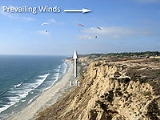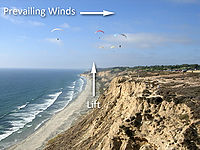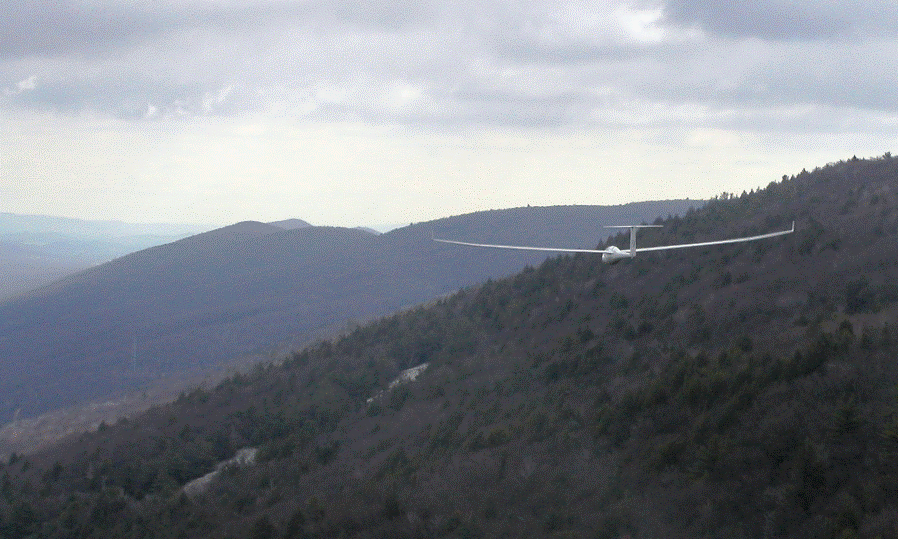
Ridge lift
Encyclopedia

Wind
Wind is the flow of gases on a large scale. On Earth, wind consists of the bulk movement of air. In outer space, solar wind is the movement of gases or charged particles from the sun through space, while planetary wind is the outgassing of light chemical elements from a planet's atmosphere into space...
strikes an obstacle, usually a mountain ridge or cliff, that is large and steep enough to deflect the wind upward.
If the wind is strong enough, the ridge lift provides enough upward force for gliders
Glider (sailplane)
A glider or sailplane is a type of glider aircraft used in the sport of gliding. Some gliders, known as motor gliders are used for gliding and soaring as well, but have engines which can, in some cases, be used for take-off or for extending a flight...
, hang gliders, paragliders and birds to stay airborne for long periods or travel great distances by 'slope soaring'. Although unpowered aircraft are usually descending through the air, they will climb if the surrounding air is rising faster than their sink rates. Model glider
Radio-controlled glider
A radio-controlled glider is a type of radio-controlled aircraft that normally does not have any form of propulsion. They are able to sustain continuous flight by exploiting the lift produced by slopes and thermals, controlled remotely from the ground with a transmitter...
enthusiasts refer to this technique as "slope gliding" or "sloping".
Orville Wright used ridge lift setting a duration record of 11 minutes in 1911. However the sport of soaring started in Germany after the First World War. In 1921 Dr. Wolfgang Klemperer broke the Wright Brothers 1911 soaring duration record with a flight of 13 minutes. In 1922 Arthur Martens became the first glider pilot
Gliding
Gliding is a recreational activity and competitive air sport in which pilots fly unpowered aircraft known as gliders or sailplanes using naturally occurring currents of rising air in the atmosphere to remain airborne. The word soaring is also used for the sport.Gliding as a sport began in the 1920s...
to use an updraft rising along a mountain slope to stay aloft for a lengthy period with a flight over an hour.
Basic requirements

Hill
A hill is a landform that extends above the surrounding terrain. Hills often have a distinct summit, although in areas with scarp/dip topography a hill may refer to a particular section of flat terrain without a massive summit A hill is a landform that extends above the surrounding terrain. Hills...
, ridge
Ridge
A ridge is a geological feature consisting of a chain of mountains or hills that form a continuous elevated crest for some distance. Ridges are usually termed hills or mountains as well, depending on size. There are several main types of ridges:...
, escarpment
Escarpment
An escarpment is a steep slope or long cliff that occurs from erosion or faulting and separates two relatively level areas of differing elevations.-Description and variants:...
or ocean wave, causing the air to rise. In meteorology this is known as orographic lift
Orographic lift
Orographic lift occurs when an air mass is forced from a low elevation to a higher elevation as it moves over rising terrain. As the air mass gains altitude it quickly cools down adiabatically, which can raise the relative humidity to 100% and create clouds and, under the right conditions,...
. The wind creates a region of rising air directly above the slope which may extend some distance upwards and outwards from its face because the airflow follows the upward contour of the hill. However at near vertical cliff
Cliff
In geography and geology, a cliff is a significant vertical, or near vertical, rock exposure. Cliffs are formed as erosion landforms due to the processes of erosion and weathering that produce them. Cliffs are common on coasts, in mountainous areas, escarpments and along rivers. Cliffs are usually...
s, there is usually an area of turbulence
Turbulence
In fluid dynamics, turbulence or turbulent flow is a flow regime characterized by chaotic and stochastic property changes. This includes low momentum diffusion, high momentum convection, and rapid variation of pressure and velocity in space and time...
with descending air near the base of the cliff. Downwind of the hill, lee waves
Lee waves
In meteorology, lee waves are atmospheric standing waves. The most common form is mountain waves, which are atmospheric internal gravity waves...
can form that are also used by glider pilots to gain height but this should not be confused with slope lift.
Near slopes rather than vertical cliffs, the strongest lift is often to be found a flight path that intersects with an imaginary line emerging at right angles from the slope.
Long mountain ranges such as those found in Ridge-and-valley Appalachians
Ridge-and-valley Appalachians
The Ridge-and-Valley Appalachians, also called the Ridge and Valley Province or the Valley and Ridge Appalachians, are a physiographic province of the larger Appalachian division and are also a belt within the Appalachian Mountains extending from southeastern New York through northwestern New...
in the United States
United States
The United States of America is a federal constitutional republic comprising fifty states and a federal district...
, New Zealand
New Zealand
New Zealand is an island country in the south-western Pacific Ocean comprising two main landmasses and numerous smaller islands. The country is situated some east of Australia across the Tasman Sea, and roughly south of the Pacific island nations of New Caledonia, Fiji, and Tonga...
, and Chile
Chile
Chile ,officially the Republic of Chile , is a country in South America occupying a long, narrow coastal strip between the Andes mountains to the east and the Pacific Ocean to the west. It borders Peru to the north, Bolivia to the northeast, Argentina to the east, and the Drake Passage in the far...
have been used by glider pilots to fly in excess of a thousand kilometers in a single flight. Birds, such as many seabird
Seabird
Seabirds are birds that have adapted to life within the marine environment. While seabirds vary greatly in lifestyle, behaviour and physiology, they often exhibit striking convergent evolution, as the same environmental problems and feeding niches have resulted in similar adaptations...
s (in particular albatross
Albatross
Albatrosses, of the biological family Diomedeidae, are large seabirds allied to the procellariids, storm-petrels and diving-petrels in the order Procellariiformes . They range widely in the Southern Ocean and the North Pacific...
) and raptor
Bird of prey
Birds of prey are birds that hunt for food primarily on the wing, using their keen senses, especially vision. They are defined as birds that primarily hunt vertebrates, including other birds. Their talons and beaks tend to be relatively large, powerful and adapted for tearing and/or piercing flesh....
s, also use slopes in this way.
See also

- GlidingGlidingGliding is a recreational activity and competitive air sport in which pilots fly unpowered aircraft known as gliders or sailplanes using naturally occurring currents of rising air in the atmosphere to remain airborne. The word soaring is also used for the sport.Gliding as a sport began in the 1920s...
- Hang glidingHang glidingHang gliding is an air sport in which a pilot flies a light and unmotorized foot-launchable aircraft called a hang glider ....
- ParaglidingParaglidingParagliding is the recreational and competitive adventure sport of flying paragliders: lightweight, free-flying, foot-launched glider aircraft with no rigid primary structure...
- Radio-controlled gliderRadio-controlled gliderA radio-controlled glider is a type of radio-controlled aircraft that normally does not have any form of propulsion. They are able to sustain continuous flight by exploiting the lift produced by slopes and thermals, controlled remotely from the ground with a transmitter...
- Controllable slope soaringControllable slope soaringControllable-slope soaring is a type of slope soaring where a slope is made to follow the airplane in gliding flight, both sustaining and controlling the airplane's trajectory by modifying the wind in the vicinity of the airplane. A controllable slope is any object which can be used to affect the...
- Orographic liftOrographic liftOrographic lift occurs when an air mass is forced from a low elevation to a higher elevation as it moves over rising terrain. As the air mass gains altitude it quickly cools down adiabatically, which can raise the relative humidity to 100% and create clouds and, under the right conditions,...
- Dynamic soaringDynamic soaringDynamic soaring is a flying technique used to gain energy by repeatedly crossing the boundary between air masses of significantly different velocity...
- ThermalThermalA thermal column is a column of rising air in the lower altitudes of the Earth's atmosphere. Thermals are created by the uneven heating of the Earth's surface from solar radiation, and are an example of convection. The sun warms the ground, which in turn warms the air directly above it...
s - Lee wavesLee wavesIn meteorology, lee waves are atmospheric standing waves. The most common form is mountain waves, which are atmospheric internal gravity waves...

